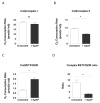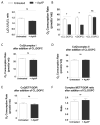Cardiolipin fatty acid remodeling regulates mitochondrial function by modifying the electron entry point in the respiratory chain
- PMID: 27085476
- PMCID: PMC4860904
- DOI: 10.1016/j.mito.2016.04.002
Cardiolipin fatty acid remodeling regulates mitochondrial function by modifying the electron entry point in the respiratory chain
Abstract
Modifications of cardiolipin (CL) levels or compositions are associated with changes in mitochondrial function in a wide range of pathologies. We have made the discovery that acetaminophen remodels CL fatty acids composition from tetralinoleoyl to linoleoyltrioleoyl-CL, a remodeling that is associated with decreased mitochondrial respiration. Our data show that CL remodeling causes a shift in electron entry from complex II to the β-oxidation electron transfer flavoprotein quinone oxidoreductase (ETF/QOR) pathway. These data demonstrate that electron entry in the respiratory chain is regulated by CL fatty acid composition and provide proof-of-concept that pharmacological intervention can be used to modify CL composition.
Keywords: Acetaminophen; Cardiolipin; Electron entry point; Electron transport chain; Mitochondria.
Copyright © 2016 Elsevier B.V. and Mitochondria Research Society. All rights reserved.
Figures





References
-
- Beyer K, Klingenberg M. ADP/ATP carrier protein from beef heart mitochondria has high amounts of tightly bound cardiolipin, as revealed by 31P nuclear magnetic resonance. Biochemistry. 1985;24:3821–3826. - PubMed
Publication types
MeSH terms
Substances
Grants and funding
LinkOut - more resources
Full Text Sources
Other Literature Sources

